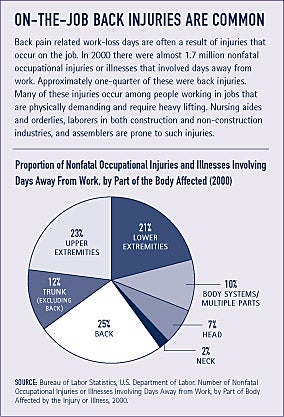Chronic Back Pain
Visit profiles to view data profiles on chronic and disabling conditions and on young retirees and older workers.
A leading cause of work limitations

Back problems are among patients’ most frequent complaints to their doctors. Nearly 65 million Americans report a recent episode of back pain. Some 16 million adults — 8 percent of all adults — experience persistent or chronic back pain, and as a result are limited in certain everyday activities. Back pain is the sixth most costly condition in the United States. Health care costs and indirect costs due to back pain are over $12 billion per year.(1) Adults with back pain are more likely to use health care services than adults without back pain. Many of the indirect costs of the condition are related to missed days of work and disability payments.This Profile uses the term “adults with back pain” to describe adults who experience persistent or chronic back pain that limits their everyday activities.
Back pain is a leading cause of work-loss days
Some 83 million days of work are lost per year due to back pain.(2) Back pain is a leading cause of work-loss days as well as work limitations. Between 1998 and 2000 the number of back pain injuries that have involved time away from work has increased. This increase follows an almost 32 percent decrease from 1994 to 1998.(3)
Among adults who are working, almost two-thirds — 64 percent — of those with back pain, compared to less than half — 45 percent — of those without back pain, have missed at least one day of work in the past year due to illness or injury. The proportion of workers who have missed many days of work is also much higher for those with back pain than for those without.
Back pain may also affect other activities. Adults with back pain spend almost 200 million days in bed a year.(4)
Back pain affects adults of all ages and incomes
In general, the characteristics of adults with back pain and the total adult population are not very different. Some differences between the two populations exist with respect to age and income, however. Some 41 percent of adults with back pain are 18 to 44 years old, compared to 54 percent of all adults. Slightly over one-quarter — 26 percent — of adults with back pain have an annual income of less than $20,000, compared to one-fifth of all adults.
One in four adults with back pain is in fair to poor physical health
Compared to adults without back pain, larger proportions of adults with any type of back pain report fair to poor mental and physical health. For example, the proportion of adults with back pain reporting fair to poor physical health — 25 percent — is more than double that of those without back pain — 11 percent (see Figure 1).

Downhearted feelings are common among adults with back pain
Substantially larger proportions of adults with back pain, compared to those without back pain, report feeling sad, worthless, or hopeless (see Figure 2). Almost three-quarters — 72 percent — of those with back pain report that such feelings have interfered with their life, compared to 61 percent of those without back pain. People with chronic back pain report significant levels of psychological distress, including feelings of anger and depression, while people who have suffered an acute episode of back pain are less likely to report these feelings.(5)

PEOPLE WHO SEE CHIROPRACTORS ARE MORE SATISFIED WITH THEIR CARE
Many people with back pain also visit chiropractors. Although people with back pain are more likely to go to a physician than to a chiropractor for relief, back pain patients who see chiropractors report that they are more satisfied with their care than those who see medical doctors. Patients who see chiropractors are more likely to say that their provider explained their treatment and provided advice on self-care.(6)
Use of certain health care services is greater for adults with back pain
Adults with any type of back pain use substantially more health care services than those without back pain. Some 83 percent of adults with any back pain, compared to 66 percent of adults without any back pain, have seen a physician at least once in the past year. The median number of annual visits to a physician by those with back pain is almost twice that of those without back pain — 5 and 3, respectively. Compared to adults without back pain, larger proportions of adults with any back pain also see non-physicians, including physical and occupational therapists.
Similarly, a larger proportion of adults with any type of back pain takes prescription medications (see Figure 3), and they fill more prescriptions on annual basis than those without back pain — 10 and 7, comparatively.

Health care expenditures are high for adults with back pain
Health care expenditures for adults with back pain are, on average, almost 2.5 times those for adults without back pain — $1,440 and $589, respectively. Expenditures for services are generally higher among adults with back pain, with the exception of emergency room visits (see Figure 4).

Adults with back pain are less active
Back pain may limit social activities. The proportion of adults with back pain reporting any limitations related to social, recreational, or family activities is more than three times the proportion of adults without any such pain (see Figure 5).

Older adults with back pain are less satisfied with their retirement
Back pain may also have an effect on how long people work. For example, among adults age 51 and older who are completely retired, one-third of those with back pain, compared to less than one-fifth of those without back pain, report that poor health was very important in their retirement decision. Among retirees, those with back pain are less satisfied with their retirement (see Figure 6).

Smaller proportions of adults with back pain are working
Some 60 percent of adults with back pain are working, compared to 74 percent of adults without back pain. This pattern holds true across all age groups, but the difference is greatest for adults ages 45 to 64 (see Figure 7).


Back pain is a leading cause of work limitations
Over 4 million adults report that they have had difficulties becoming or remaining employed due to back pain. It is the leading cause of work limitations among adults ages 18 to 64, reported by one in five. And among adults age 65 and older, back pain is the fourth leading cause of work limitations.
Earnings are lower for workers with back pain
Among the group of adults who have difficulties at work caused by back pain, annual earnings — $18,480 — are substantially less than those of adults who do not experience any difficulties at work — $24,480. Differences are greatest among younger workers. Those who experience work limitations due to back pain earn two-thirds of the amount earned by workers who do not experi-ence back pain (see Figure 8).

1. B. Druss, Marcus, S., Olfson, M., and Pincus, H.A. (2002). “The Most Expensive Medical Conditions in America.” Health Affairs, 21(4): 105-111.
2. Ibid.
3. United States Department of Labor, Bureau of Labor Statistics. (2002). “Lost-Worktime Injuries and Illnesses: Characteristics and Resulting Time Away From Work.” USDL News Release 02-196.
4. Druss, et al. (2002).
5. M. BenDebba, W. S. Torgerson, D. M. Long (1997). “Personality Traits, Pain Duration and Severity, Functional Impairment, and Psychological Distress in Patients with Persistent Low Back Pain.” Pain 72: 115-125.
6. R. P. Hertzman-Miller, H. Morganstern, E. L. Hurwitz, Fei, Y., Adams, A. H., Harber, P., and Kominiski, G. F. (2002). “Comparing the Satisfaction of Low Back Pain Patients Randomized to Receive Medical or Chiropractic Care: Results from the UCLA Low-Back Pain Study.” American Journal of Public Health, 92(10): 1628-1633.
ABOUT THE DATA
Unless otherwise noted, the data presented in this Profile are from four national surveys of the United States civilian non-institutionalized population. The 2000 National Health Interview Survey (NHIS), conducted annually by the National Center for Health Statistics, is the principal source of information on the health of the U.S. population. Adults with back pain in the NHIS include those who report that they have difficulty with daily activities due to chronic back and neck pain. The 1999 Medical Expenditure Panel Survey (MEPS), cosponsored by the Agency for Healthcare Research and Quality and the National Center for Health Statistics, provides national estimates of health care use, expenditures, sources of payment, and insurance coverage. Data from the MEPS pertains to all adults who report any back pain (including an acute episode). The 1998 Health and Retirement Study (HRS) survey of people age 51 and older is sponsored by the National Institute on Aging and conducted by the Institute for Social Research at the University of Michigan. HRS data refers to adults who have ever had persistent or troublesome back pain or problems. The Survey of Income and Program Participation (SIPP), a panel study conducted by the U.S. Census Bureau, contains a supplement on Adult Disability. Data from SIPP pertain to adults who first indicate that they are limited in their work-related activities, and then identify chronic back pain as the cause of their limitation.
ABOUT THE PROFILES
This is the second set of Data Profiles in the series, Challenges for the 21st Century: Chronic and Disabling Conditions. The series is supported by a grant from the Robert Wood Johnson Founda-tion. This Profile was written by Lee Shirey and Susan Rogers. Previous Profiles in the new series include:
1. Screening for Chronic Conditions: Underused services
2. Childhood Obesity: A lifelong threat to health
3. Visual Impairment: A growing concern as the population ages
4. Cancer: A major national concern
5. Prescription Drugs: A vital component of health care
6. Chronic Obstructive Pulmonary Disease: A chronic condition that limits activities
7. Rural and Urban Health: Health care service use differs
The Center on an Aging Society is a Washington-based nonpartisan policy group located at Georgetown University’s Institute for Health Care Research and Policy. The Center studies the impact of demographic changes on public and private institutions and on the economic and health security of families and people of all ages.


